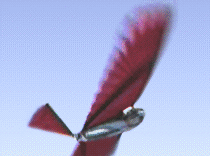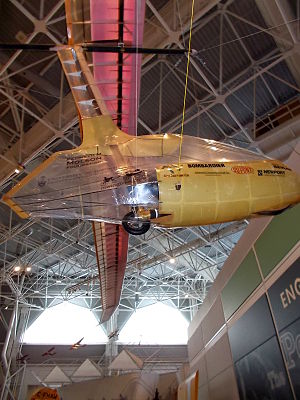
An ornithopter is an aircraft that flies by flapping its wings. Designers sought to imitate the flapping-wing flight of birds, bats, and insects. Though machines may differ in form, they are usually built on the same scale as flying animals. Larger, crewed ornithopters have also been built and some have been successful. Crewed ornithopters are generally either powered by engines or by the pilot.
Snowbird is a common name for the dark-eyed junco.

The Canadair CT-114 Tutor is a jet trainer that was designed and produced by Canadian aircraft manufacturer Canadair. It served as the standard jet trainer of the Royal Canadian Air Force (RCAF), and later Canadian Armed Forces, between the early 1960s and 2000.

A conventional fixed-wing aircraft flight control system (AFCS) consists of flight control surfaces, the respective cockpit controls, connecting linkages, and the necessary operating mechanisms to control an aircraft's direction in flight. Aircraft engine controls are also considered flight controls as they change speed.

An Entomopter is an aircraft that flies using the wing-flapping aerodynamics of an insect. The word is derived from entomo + pteron. Entomopters are type of ornithopter, which is the broader term for any device intended to fly by flapping wings.
James D. DeLaurier is an inventor and professor emeritus of the University of Toronto Institute for Aerospace Studies. He is a leader in design and analysis of lighter than air vehicles and flapping winged aircraft.
The UTIAS Ornithopter No.1 is an ornithopter that was built in Canada in the late 1990s. On 8 July 2006, it took off under its own power, assisted by a turbine jet engine, making a flight of around 300 metres that lasted 14 seconds, after which it crashed.

In aeronautics, a flexible wing is an airfoil or aircraft wing which can deform in flight.

Gliding is a recreational activity and competitive air sport in which pilots fly unpowered aircraft known as gliders or sailplanes using naturally occurring currents of rising air in the atmosphere to remain airborne. The word soaring is also used for the sport.

A human-powered aircraft (HPA) is an aircraft belonging to the class of vehicles known as human-powered transport.
Yves Rousseau is a French inventor and aviator credited with multiple ultralight aircraft FAI world records. He has received international recognition for his 13 years of work on human-powered ornithopter flight. Rousseau attempted his first human-powered flight with flapping wings in 1995.
This is a list of aviation-related events from 2010.

A glider or sailplane is a type of glider aircraft used in the leisure activity and sport of gliding. This unpowered aircraft can use naturally occurring currents of rising air in the atmosphere to gain altitude. Sailplanes are aerodynamically streamlined and so can fly a significant distance forward for a small decrease in altitude.

The König SC 430 is a three-cylinder, two-stroke, single ignition radial aircraft engine designed for powered paragliders and single place ultralight trikes.

The Canadian Air and Space Conservancy was an aviation museum that was located in Toronto, Ontario, featuring artifacts, exhibits and stories illustrating a century of Canadian aviation heritage and achievements. The museum was located in a hangar that once housed the original de Havilland Canada aircraft manufacturing building, but in September 2011 the museum and all of the other tenants in the building were evicted by the landlord, the Crown Corporation, PDP. The site was slated for redevelopment as a new sports centre but after closing the museum the development was placed on hold. The museum is developing a new location and its collections are currently not available for public viewing.

Great Lakes Gliding Club (GLGC) is a soaring club located at Tottenham/Ronan Aerodrome, 56.9 km northwest of Toronto, Ontario, Canada.
SHARP, short for Stationary High Altitude Relay Platform, was an experimental aircraft using beam-powered propulsion designed by the Communications Research Centre Canada (CRC) and built by the University of Toronto Institute for Aerospace Studies (UTIAS) during the 1980s. SHARP used microwaves to provide energy from a ground station that powered electric motors spinning propellers to keep the aircraft aloft. The power was also used for the onboard electronics. SHARP could remain aloft indefinitely, and was intended to be used as a sort of low-altitude communications satellite for smaller geographical areas.

The AeroVelo Atlas is a human-powered helicopter (HPH) that was built for AHS International's Igor I. Sikorsky Human Powered Helicopter Competition. On 13 June 2013, it became the first aircraft to achieve the goals of the competition and thus won the prize.












